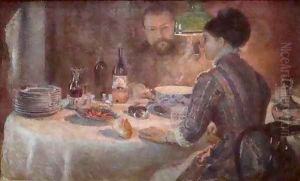Marie Bracqemond Paintings
Marie Bracquemond was a French Impressionist painter who was born on December 1, 1840, in Argenton-en-Landunvez, near Brest, Brittany. Despite her significant talent and contributions to the Impressionist movement, her work has often been overshadowed by her male contemporaries. Bracquemond was one of the 'les trois grandes dames' of Impressionism, alongside Berthe Morisot and Mary Cassatt.
Marie began her artistic training at a young age, and her skill quickly attracted the attention of established artists. She was introduced to the Impressionist circle through her husband, Félix Bracquemond, a respected engraver and ceramicist. He was supportive of her work but also very domineering, which often led to tensions in their creative and personal lives. Despite these challenges, Marie Bracquemond's work was included in several of the Impressionist exhibitions that defined the movement.
Throughout her career, Bracquemond's style evolved from a traditional, academic approach to embrace the lighter color palette and open compositions of Impressionism. She experimented with plein air painting, a technique favored by the Impressionists, which involved working outdoors to capture the transient effects of light. Her subjects often included domestic scenes, landscapes, and portraits, through which she conveyed a sense of modern life and feminine sensibility.
However, her career was cut short due to the increasing tension with her husband over her artistic endeavors and the social constraints placed on women artists at the time. Her last known works date from around 1890, after which she ceased to paint almost entirely. Despite her withdrawal from the art world, her works continued to be recognized posthumously for their contribution to the Impressionist movement.
Marie Bracquemond died on January 17, 1916, in Paris. Although her artistic output was relatively small and she remains less well-known than her male counterparts, her work has gained more recognition in recent years. Art historians and feminist scholars have worked to re-evaluate her contributions and place her rightfully as a significant figure within the Impressionist movement.
